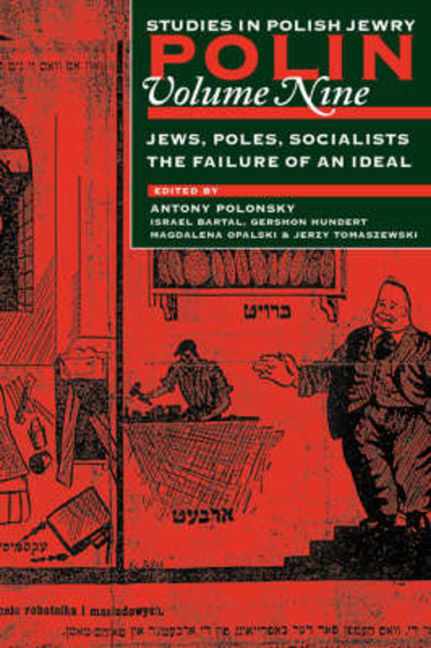Book contents
- Frontmatter
- Dedication
- Editors and Advisers
- Preface
- Acknowledgement
- Polin
- Polin: Studies in Polish Jewry
- Contents
- Note on Transliteration, Names, and Place Names
- Abbreviations
- Introduction
- PART I POLES, JEWS, SOCIALISTS: THE FAILURE OF AN IDEAL
- PART II NEW VIEWS
- PART III REVIEWS
- REVIEW ESSAYS
- BOOK REVIEWS
- Alfred Ebenbauer and Klaus Zatloukal (eds.), Die Juden in ihrer mittelalterlichen Umwelt
- Rivka Schatz-Uffenheimer, Hasidism as Mysticism
- Jadwiga Maurer, ‘Z matki obcej … ’
- Władyslaw T. Bartoszewski and Antony Polonsky (eds.), The Jews in Warsaw
- Maria Klańska, Problemfeld Galizien in deutschsprachiger Prosa 1846-191
- Israel Oppenheim, Tenuat Heḥaluts bePolin, 1929-1939
- The Letters of Martin Duber, ed. Nahum N. Glatzer and Paul Mendes-Flohr
- Alexander Heider, A Dictionary of Jewish Surnames from the Russian Empire
- Alice L. Eckardt (ed.), Burning Memory
- Ruta Sakowska, Ludzie z dzielnicy zamkniętej
- lwona Irwin-Zarecka, Neutralizing Memory
- Stanislaw Meducki and Zenon Wrona (eds.), Antyzydowskie wydarzenia kieleckie, 4 lipca 1946
- Bibliography Of Polish-Jewish Studies, 1993
- Notes on Contributors
- Notes on Translators
- Glossary
- Index
Ruta Sakowska, Ludzie z dzielnicy zamkniętej
from BOOK REVIEWS
- Frontmatter
- Dedication
- Editors and Advisers
- Preface
- Acknowledgement
- Polin
- Polin: Studies in Polish Jewry
- Contents
- Note on Transliteration, Names, and Place Names
- Abbreviations
- Introduction
- PART I POLES, JEWS, SOCIALISTS: THE FAILURE OF AN IDEAL
- PART II NEW VIEWS
- PART III REVIEWS
- REVIEW ESSAYS
- BOOK REVIEWS
- Alfred Ebenbauer and Klaus Zatloukal (eds.), Die Juden in ihrer mittelalterlichen Umwelt
- Rivka Schatz-Uffenheimer, Hasidism as Mysticism
- Jadwiga Maurer, ‘Z matki obcej … ’
- Władyslaw T. Bartoszewski and Antony Polonsky (eds.), The Jews in Warsaw
- Maria Klańska, Problemfeld Galizien in deutschsprachiger Prosa 1846-191
- Israel Oppenheim, Tenuat Heḥaluts bePolin, 1929-1939
- The Letters of Martin Duber, ed. Nahum N. Glatzer and Paul Mendes-Flohr
- Alexander Heider, A Dictionary of Jewish Surnames from the Russian Empire
- Alice L. Eckardt (ed.), Burning Memory
- Ruta Sakowska, Ludzie z dzielnicy zamkniętej
- lwona Irwin-Zarecka, Neutralizing Memory
- Stanislaw Meducki and Zenon Wrona (eds.), Antyzydowskie wydarzenia kieleckie, 4 lipca 1946
- Bibliography Of Polish-Jewish Studies, 1993
- Notes on Contributors
- Notes on Translators
- Glossary
- Index
Summary
The first edition of this book, published in 1975, was limited to 2,000 copies, which disappeared with lightning speed. Evidence of its popularity is the none too edifying fact that all copies were stolen both from the library of the University of Warsaw and from the Jewish Historical Institute. For this reason alone the reissue of this weighty volume is a laudable initiative by the publisher.
Ludzie z dzielnicy zamkniętej is the first work in the Polish language which describes life in the Warsaw ghetto based on documents of the underground archives of the ghetto, named, after its founder, the Ringelblum Archives. The author attempted to engage polemically with the most popular stereotypes, as much those prevalent among Poles as those which Jews often hold with reference to their own history. One of these is the conviction of the passivity of the Jewish population in the face of annihilation. This characteristic was supposedly never challenged until the resistance of ‘a handful of heroes, fighting for human dignity’. Such statements, suggesting a lack of dignity in those who missed taking an active part in the fight, appear even today, repeated ad infinitum in the press coverage of the fiftieth anniversary of the Warsaw Uprising. That is why I heartily recommend this book to all journalists and ask them not to repeat this thoughtless slogan in the future.
Stressing the strength of the civilian opposition in the ghettos, as well as its close connection with the conspiracy movement, the author calls attention to their mutual connection and co-operation, thanks to which social aid in the ghetto was conducted as much out in the open, through the work of institutions connected with the Judenrat, as in conspiracy in the form of voluntary, spontaneous activity by, for example, home committees, as well as through the organized activity of political organizations which arose in the underground but, simultaneously co-operated closely with the Judenrat. Various forms of civilian resistance, analysed in depth by the author, created an informal council in the ghetto; its existence and multifarious activity made possible an easy transformation into armed resistance.
- Type
- Chapter
- Information
- Jews, Poles, Socialists: The Failure of an Ideal , pp. 297 - 299Publisher: Liverpool University PressPrint publication year: 2008

